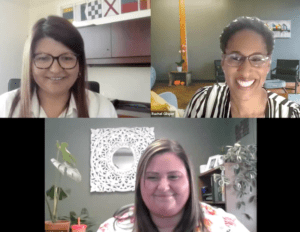Who is a member?
Our members are the local governments of Massachusetts and their elected and appointed leadership.

A webinar for municipal officials showcased timely hiring strategies to help communities navigate different stages of the recruitment process. Speakers included (clockwise from top left) Jen Breaker, assistant town manager and communications director in Danvers, Rachel Glisper, principal of Crossroads DEIB and vice president of GovHR and Caitlyn Julius, assistant human resources director in Springfield.
The MMA today hosted the third in a series of webinars for municipal officials that showcase timely hiring strategies to help communities navigate different stages of the recruitment process.
“What Happens After the Offer” emphasized how to optimize the onboarding process and strengthen organizational integration. It also highlighted a municipality’s unique employee benefits.
The session was led by Jen Breaker, the assistant town manager and communications director in Danvers, and Caitlyn Julius, the assistant human resources director in Springfield, along with Rachel Glisper, principal of Crossroads DEIB and vice president of GovHR.
Glisper discussed the difference between orientation and onboarding. Orientation, she said, is the initial welcome given by an employer, while onboarding is a comprehensive process that helps a new employee learn the responsibilities of his or her position. When onboarding and orientation are handled properly, with attention given to the new hire’s needs, both processes can be enormously beneficial to long-term employee retention.
Julius said orientation begins with meeting an employee during the interview stage, which is the first opportunity to make impressions. She said it’s important to consider what your orientation and onboarding process say about your municipality.
Each new employee is unique and will have individual needs, Glisper said, but it’s essential to build a process that contains some “rinse and repeat” elements to avoid reinventing the wheel with each new hire. Breaker shared a color-coding method used for paperwork in Danvers, which helps employees quickly determine tasks that need to be prioritized before their first day of employment or within their first 30 days.
Julius discussed tools and methods for streamlining and “right-sizing” the onboarding process for your community. One suggestion was to turn paperwork into fillable PDFs, and to send policies and paperwork to new employees before their start date to speed up the process. Julius emphasized the importance of familiarizing new hires with their work environment by facilitating meetings about benefits and retirement, sharing frequently used contact lists, and conducting a tour.
Breaker discussed how to build an equitable and sustainable onboarding process across the organization, and Glisper added the importance of fostering psychological safety throughout the process. New hires must feel safe and secure to engage in the learning process by asking questions, giving and receiving feedback, experimenting, and making mistakes.
During a 15-minute question and answer period, attendees asked about adapting the process for seasonal employees, best practices for communities with limited staff, and the role of mentoring when onboarding new hires.
The final Reframing Recruitment webinar, “Key Takeaways from Vacancy to Post-Recruitment” will be held on June 14.
• Reframing Recruitment: What Happens After the Offer presentation (15M PDF)